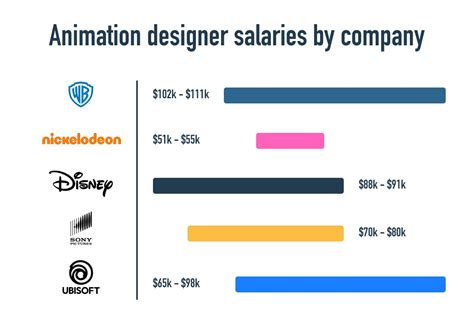Are you considering a career in animation? Do you wonder about the earning potential in the industry? Look no further, as we delve into the world of animator salaries in this comprehensive breakdown. From the average pay for animators worldwide to the factors that affect these salaries, we’ve got you covered. We’ll also explore how experience level, regional differences, and specializations can impact earnings, as well as the benefits and perks that come with working in the animation industry. Additionally, we’ll compare salaries in 2D versus 3D animation and discuss the rising demand for animators and its effect on pay. Finally, we’ll take a look at future trends in animator earnings and offer some tips for negotiating salaries as an animator. Whether you’re just starting out or looking to advance your career, understanding the financial landscape of the animation industry is crucial. Read on to gain insight into the earning potential and future prospects for animators.
Table of Contents
Average salary for animators worldwide
As an animator, one of the most important factors to consider when choosing a career path is the potential salary. Understanding the average salary for animators worldwide can help you make informed decisions about your future. According to recent data, the average annual salary for animators worldwide is around $75,000. Of course, this figure can vary greatly depending on a number of factors.
One of the most significant factors that can affect an animator’s salary is their level of experience. Animators with more experience typically command higher salaries than those who are just starting out in the industry. It’s not uncommon for senior animators to earn six-figure salaries, while entry-level animators may start out earning closer to $40,000 per year.
Another important consideration is the animator’s specialization. Certain specializations, such as 3D modeling and special effects, tend to command higher salaries than others. Additionally, differences in regional pay scales can have a significant impact on the average salary for animators. For example, animators working in major metropolitan areas or in countries with a strong animation industry tend to earn higher salaries than those working in smaller markets.
Overall, it’s clear that there are many factors that can impact an animator’s salary. Understanding the average salary for animators worldwide is just the first step in making informed decisions about your career in animation.
Factors that affect animator salaries
One of the key factors that affect animator salaries is the level of experience that an animator possesses. Generally, animators with more years of experience are able to command higher salaries than those who are just starting out in the industry. This is because experienced animators have honed their skills over time and are able to produce high-quality work more efficiently, making them more valuable to employers.
Another important factor is the animator’s specialization. Certain specializations within the animation industry, such as 3D modeling or character design, often command higher salaries than others due to the level of skill and expertise required. Animators who have developed specialized skills in high-demand areas are in a better position to negotiate higher salaries with employers.
Additionally, the location of the animator can have a significant impact on their salary. Regional differences in animator pay exist due to variations in the cost of living and demand for animators in different areas. For example, animators working in major metropolitan areas or in countries with a strong animation industry may be able to earn higher salaries compared to those working in less competitive markets.
Lastly, the size and reputation of the employer can also play a role in determining an animator’s salary. Large, well-established animation studios or companies may offer higher salaries and additional perks to attract top talent, while smaller or lesser-known employers may not have the same level of resources to offer competitive compensation packages.
How experience level impacts earnings
Experience level plays a crucial role in determining the earnings of animators. As animators gain more experience in the industry, their value and expertise also increases. This typically leads to higher earning potentials as they become more proficient in their craft and take on more challenging projects.
Entry-level animators may start with a lower salary compared to their more experienced counterparts. However, as they gain experience and develop their skills, they can negotiate for higher pay rates or seek out positions that offer better compensation packages. Experience level also affects the type of projects an animator is qualified for, which can directly impact their earning potential.
In addition, experienced animators may have the opportunity to advance into leadership roles, such as animation directors or supervisors. These positions often come with higher salaries and additional perks, further demonstrating how experience level can impact earnings in the animation industry.
Overall, the correlation between experience level and earnings in the animation field highlights the importance of continuous learning and skill development to maximize one’s earning potential over time.
Regional differences in animator pay
When it comes to animator salaries, geographic location can play a significant role in determining how much you earn. Different regions around the world offer varying compensation packages for animators, influenced by factors such as cost of living, demand for talent, and industry competitiveness.
In developed countries such as the United States and Canada, animators tend to earn higher salaries compared to their counterparts in developing nations. This is partly due to the higher cost of living in these regions, as well as the presence of well-established animation studios and a strong demand for skilled professionals.
On the other hand, in regions with emerging animation industries, such as parts of Asia and Latin America, animator salaries may be lower. While the cost of living in these areas is generally lower, the animation industry may not be as mature or developed, leading to less competitive compensation for animators.
It’s important for animators to consider regional differences when evaluating job opportunities and negotiating salaries. Understanding the cost of living and average salary benchmarks in different regions can help you make informed decisions about where to pursue your career and what level of compensation to expect.
Specializations that command higher salaries
When it comes to the animation industry, not all specializations are created equal. Some areas of expertise command higher salaries due to various factors such as demand, skill level, and specialization. One of the specializations that consistently commands higher salaries is character animation. Character animators are responsible for bringing to life the movements and expressions of animated characters, and their work is crucial to the success of any animated production.
Another specialization that often leads to higher salaries is visual effects (VFX) animation. VFX animators are skilled in creating realistic, computer-generated effects that are seamlessly integrated into live-action footage. This specialization requires a high level of technical expertise and creativity, which is why professionals in this field are often compensated at a higher rate.
Additionally, specializations in 3D modeling and rigging also tend to command higher salaries. 3D modelers are responsible for creating realistic and detailed 3D models of characters, props, and environments, while riggers are tasked with creating the digital skeletons and controls that allow these models to move and behave realistically. Both of these specializations require a high level of technical skill and attention to detail, which is reflected in the higher salaries these professionals often receive.
Overall, the animation industry offers a wide range of career opportunities, but some specializations have a higher earning potential than others. Those who specialize in character animation, VFX animation, 3D modeling, and rigging tend to command higher salaries due to the specialized skills and expertise required in these areas.
Comparing salaries in 2D vs. 3D animation
When it comes to the animation industry, there are various factors that can affect the salaries of animators. One of the most significant factors is the type of animation they specialize in, whether it’s 2D or 3D animation. Both 2D and 3D animation have their own unique skill sets and demands, and as a result, the salaries for animators working in these different fields can vary.
For animators specializing in 2D animation, the average salary may differ from those working in 3D animation due to the complexity and demand for each type. In general, 3D animation tends to command higher salaries, as it requires a more advanced skill set and technical expertise. Additionally, 3D animation is often used in larger-scale projects such as feature films and video games, which can offer higher earning potential compared to 2D animation projects.
However, it’s important to note that the demand for 2D animation hasn’t diminished, especially in industries such as television, advertising, and web design. While 2D animation may be perceived as less lucrative compared to 3D animation, there are still opportunities for well-paying jobs in this field, particularly for animators with specialized skills and experience.
Ultimately, the decision between specializing in 2D or 3D animation should be based on individual preferences, career goals, and the specific job market. Both types of animation offer their own set of challenges and rewards, and animators should carefully consider their strengths and interests when choosing their specialization.
Benefits and perks in the animation industry
Working in the animation industry comes with a variety of benefits and perks that are not always available in other professions. One of the most notable advantages is the opportunity to work on creative and innovative projects that can be incredibly rewarding. Whether it’s creating characters for a blockbuster movie or designing an interactive game, animators have the chance to bring their ideas to life and make a lasting impact on audiences around the world.
Another major benefit of working in animation is the potential for career growth and advancement. As technology continues to advance, the demand for skilled animators is expected to grow, creating opportunities for professionals to take on more challenging and higher-paying roles. Many companies also offer training and professional development programs to help their employees stay current with the latest software and techniques, which can further enhance career prospects.
Additionally, the animation industry often provides flexible working arrangements and work-life balance options. With the ability to work remotely and choose flexible hours, animators have the freedom to create a schedule that suits their individual needs. This can be especially appealing for those who value autonomy and independence in their work, as well as those who may have other personal commitments outside of their professional obligations.
Finally, many companies in the animation industry offer competitive salary and benefits packages to attract and retain top talent. These packages may include health insurance, retirement savings plans, and other perks such as free meals, on-site fitness facilities, and company-sponsored social events. These benefits can contribute to a positive and supportive work environment, making the animation industry an attractive option for those seeking a rewarding and fulfilling career.
Negotiating salaries as an animator
When it comes to negotiating salaries as an animator, it’s important to consider several factors that can impact your potential earnings. One of the key elements to keep in mind is your level of experience. As an animator with years of experience under your belt, you may have more leverage when it comes to negotiating a higher salary. Additionally, the demand for animators in your region can also play a role in how much you can expect to earn. If the demand is high, you may have more flexibility to negotiate for a higher salary.
Another important aspect to consider when negotiating your salary as an animator is your specialization. Certain specializations within the animation industry, such as 3D modeling or character design, may command higher salaries than others. It’s essential to research the average salaries for your specific area of expertise to have a better understanding of what you can negotiate for.
Furthermore, benefits and perks offered by potential employers can also be an important factor in the negotiation process. While a higher salary is always appealing, additional benefits such as health insurance, paid time off, or opportunities for professional development can also add significant value to your overall compensation package.
Ultimately, when negotiating your salary as an animator, it’s crucial to come prepared with research, confidence, and a clear understanding of your worth. By considering your experience level, specialization, regional demand, and additional benefits, you can position yourself for a successful negotiation and potentially secure a higher salary in the animation industry.
Rising demand for animators and its effect on pay
As the demand for animators continues to rise in various industries, the effect on pay is becoming increasingly evident. With the growing need for animated content in advertising, entertainment, gaming, and virtual reality, animators are finding themselves in high demand. This surge in demand has not only led to increased job opportunities but also to competitive salaries for those in the field.
The rising demand for animators has also affected pay by creating a market for specialized skills. As companies seek to stand out through unique, high-quality animation, animators with specialized knowledge in areas such as 3D modeling, character design, and visual effects are commanding higher salaries. This shift towards specialization has allowed animators to leverage their expertise and negotiate for higher pay, reflecting the increasing demand for their skills.
Furthermore, the rise in demand for animators has led to opportunities for freelancers and remote workers. With advancements in technology and the ability to collaborate across borders, animators are no longer limited to local job markets. This broader scope of opportunities has enabled animators to seek out higher-paying projects and clients, ultimately influencing pay rates within the industry.
Looking towards the future, the continued growth in demand for animators is expected to further impact pay rates. As the need for animated content expands into new sectors such as education, healthcare, and augmented reality, animators can anticipate even more lucrative opportunities and competitive salaries. Ultimately, the rising demand for animators is reshaping the industry and leading to favorable prospects for those pursuing a career in animation.
Future trends in animator earnings
In the rapidly evolving world of animation, future trends in animator earnings are a topic of keen interest. As technology continues to advance, demand for skilled animators is expected to grow, leading to potential changes in animator salaries. The rise of virtual reality, augmented reality, and other cutting-edge technologies is opening up new opportunities for animators, and these innovative fields may offer higher earning potential for those with the right skills.
Another important trend that could impact animator earnings in the future is the increasing globalization of the entertainment industry. As animation becomes more integrated into a wide range of media, including film, television, video games, and online content, animators may find new opportunities and higher demand in international markets. This could lead to changes in compensation as animators with global experience and language skills become more valuable.
Furthermore, the growing emphasis on digital streaming platforms and online content creation is likely to affect animator earnings in the coming years. With the rise of streaming services and digital entertainment channels, there will be a greater need for original animated content, as well as for animators who can adapt to new formats and platforms. This shift in the industry landscape may lead to new avenues for monetization and increased earning potential for animators.
Lastly, the ongoing shift towards freelance and remote work in the animation industry is expected to influence animator earnings. As more companies and studios embrace remote collaboration and flexible work arrangements, animators may find opportunities to work on a wider range of projects and with clients from around the world. This could lead to new ways of generating income and potentially higher overall earnings for animators who are able to take advantage of these changes.





